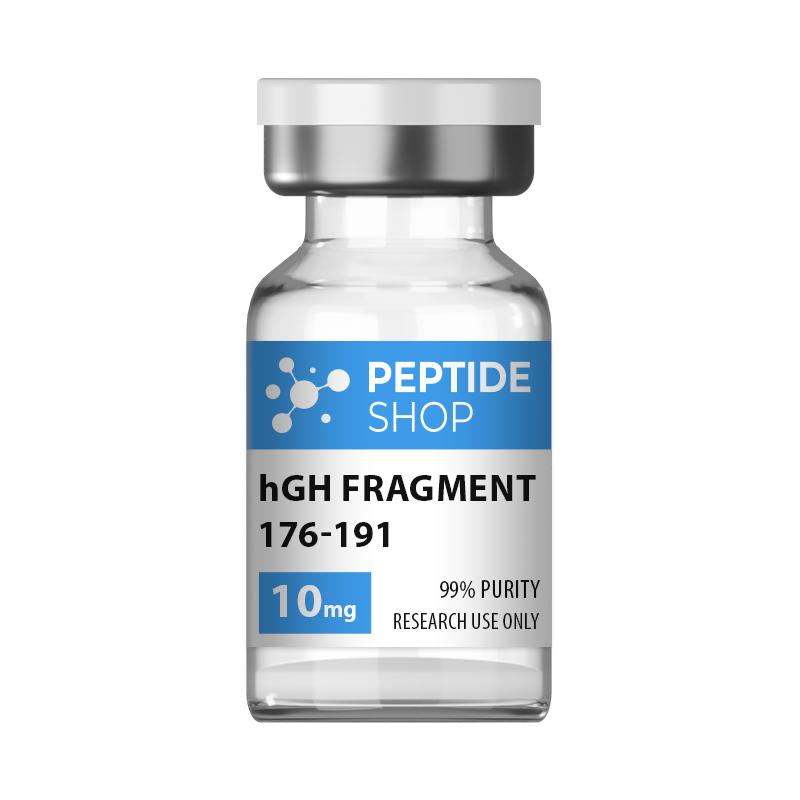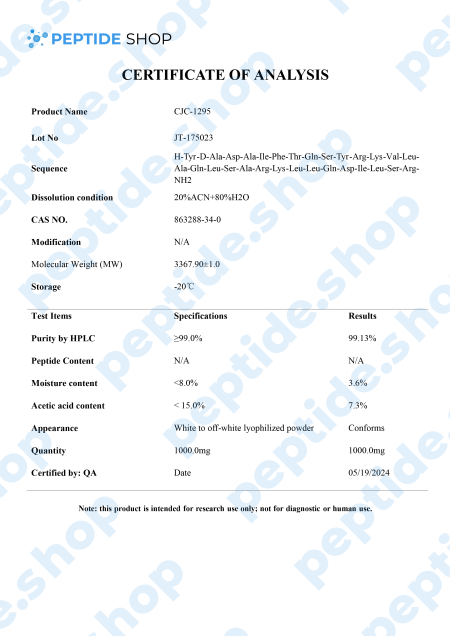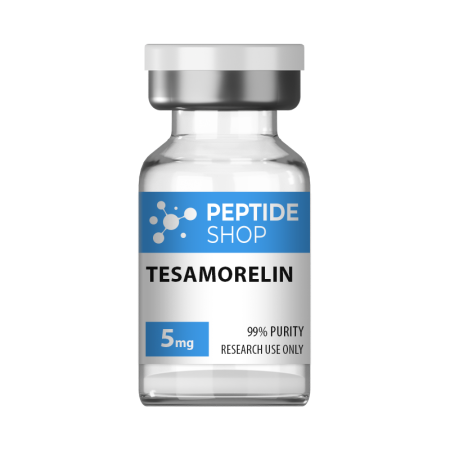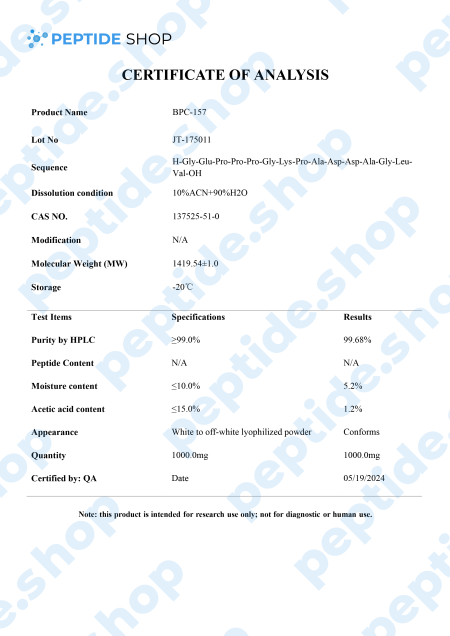hGH Fragment 176-191
Numerous studies have shown that this peptide may represent numerous opportunities for competent scientists to investigate, especially cartilage regeneration and fatty tissue mitigation.
What is Fragment 176-191 peptide?
This synthetic amino acid sequence mimics the hGH sequence, starting from position 177 to position 191.
AOD 9604, or “lipolytic extract,” is another name for Fragment 176-191. Many researchers argue that Fragment 177-191 may be an important research compound in the context of obesity. They believe it can potentially burn fat in animal models in laboratory settings.
Despite positive results, Fragment 176-191 hasn’t been used for human research purposes and doesn’t have official medical approvals.
Growth hormone
According to research, it appears that hGH Fragment 176-191 may not produce any side effects often related to hGH supplementation. Several adverse effects, such as, impaired glucose tolerance, insulin resistance, and increases in IGF-a levels, have cast doubt on hGH’s use as an obesity treatment. However, when it comes to hGH Fragment 176-191, it doesn’t seem to be impacting blood IGF-1 levels or negatively affecting carbohydrate metabolism.
A trial conducted on Zucker rats in 2000 showed no detrimental effects on insulin sensitivity. Also, an investigation on obese mice done in 2001 did not seem to affect insulin secretion.
Properties
Studies conducted on animals suggest that this peptide can exhibit significant theoretical properties, which will be outlined below:
- The main potential of this Fragment is its lipolytic properties or, in other words, fat-reducing potential. While growth hormones promote development in infancy, they have also been speculated to have an important purpose in maturity.
- Lipoprotein lipase inhibitors may be activated in fat cells,
- By stimulating lipolysis in adipocytes may lead to a decrease in fat cell bulk,
- It might lead to loss of fat from the host body,
Weight
A 14-day trial researching overweight mice came to a conclusion that Fragment 176-191 may have increased skeletal muscle thermogenesis and boosted fat burning.
The study results indicated that this peptide may have enhanced beta (3)-AR RNA (ADRB3) levels, which caused rapid weight reduction in overweight animals but didn’t have much effect on lean mice.
Cartilage
Based on other animal research, it appears that hGH Fragment 176-191 may boost the effects of hyaluronic acid (HA). When Fragment 176-191 was combined with hyaluronic acid, it might boost cartilage formation in white rabbits which have issues with osteoporosis.
References:
Habibullah MM, Mohan S, Syed NK, Makeen HA, Jamal QMS, Alothaid H, Bantun F, Alhazmi A, Hakamy A, Kaabi YA, Samlan G, Lohani M, Thangavel N, Al-Kasim MA. Human Growth Hormone Fragment 176-191 Peptide Enhances the Toxicity of Doxorubicin-Loaded Chitosan Nanoparticles Against MCF-7 Breast Cancer Cells. Drug Des Devel Ther. 2022 Jun 27;16:1963-1974. doi: 10.2147/DDDT.S367586. PMID: 35783198; PMCID: PMC9249349.
https://www.sciencedirect.com/science/article/abs/pii/0304416582900332
Habibullah, Mahmoud & Mohan, Syam & Syed, Nabeel & Makeen, Hafiz & Jamal, Qazi & Alothaid, Hani & Bantun, Farkad & Hakamy, Ali & Kaabi, Yahia & Samlan, Ghalia & Lohani, Mohtashim & Thangavel, Neelaveni & Al-Kasim, Mohamed. (2022). Human Growth Hormone Fragment 176–191 Peptide Enhances the Toxicity of Doxorubicin-Loaded Chitosan Nanoparticles Against MCF-7 Breast Cancer Cells. Drug Design, Development and Therapy. 16. 1963. 10.2147/DDDT.S367586.
$80.00
| Quantity: | 10 mg |
|---|---|
| Unit: | 1 vial |
| Contents: | hGH Fragment 176-191 |
| Form/Appearance: | Lyophilized/Powder |
| Peptide Purity: | 99% |
| Sequence: | Tyr-Leu-Arg-Ile-Val-Gln-Cys-Arg-Ser-Val-Glu-Gly-Ser-Cys-Gly-Phe |
| Molecular Mass: | 1817.12 g/mol |
| Solubility: | Sterile / Bacteriostatic water |
| Synonyms: | Lipolytic fragment |
Based on 0 reviews
|
|
|
0% |
|
|
|
0% |
|
|
|
0% |
|
|
|
0% |
|
|
|
0% |
FAQs
Related Products
If you’re a peptide researcher (or plan on becoming one), you should know the difference between CJC-1295 and CJC-1295 DAC. CJC-1295 DAC features an additional component at the end of the peptide chain, also known as a drug affinity complex or DAC.
This small fragment changes the peptide’s functionality and extends its half-life to six to eight days. It might have a prolonged effect of up to two weeks.
Below, we will showcase the main similarities and differences between these two peptides, including their properties, characteristics, and mechanism of action.
What is CJC-1295 DAC peptide?
This peptide resembles the regular CJC-1925 since it is a modified form of natural GHGR (1-29). However, this one differs from CJC-1925. It has an additional molecule known as a “drug affinity complex.”
DAC features a couple of oxygen and nitrogen atoms connected by chemical bonds. According to some findings, this small number of atoms could significantly impact peptide breakdown rate and its use in the body.
What is CJC-1295 Peptide?
This peptide is also known as “modified growth hormone releasing factor (1-29)”, “ModGRF 1-29”, or “Modified GRF (1-29).” You may also encounter the name “CJC-1295, without DAC.”
All these names imply a specific peptide molecule containing a short amino acid chain. As many studies have indicated, this peptide may boost growth hormones in the bloodstream.
Growth hormone may have a significant role in several vital internal activities. It could facilitate cellular reproduction, repair, and growth, help with tissue repair, improve muscle cell development, support skin cells, and other functions.
While the body naturally produces growth hormone, this production tends to naturally decrease. According to some research done in laboratory settings, CJC-1295 may encourage the natural production of growth hormone, increasing its levels, which could lead to quicker repair, fat cell burn, and muscle cell growth.
Differences between CJC-1295 DAC and CJC-1295
As research studies have outlined, here are some fundamental differences between these two peptides.
Half-life
The main distinction lies in their half-lives. CJC-1295 is thought to mimic the body’s natural peptide. The endogenous GHRH has a short half-life of just a couple of minutes. Similarly, CJC-1295 has a brief half-life of around half an hour.
Regarding the second peptide, the additional DAC could significantly alter the organism’s peptide use. Researchers believe that DAC offers a peptide, a lysine linker, which could protect and prevent it from degrading.
Moreover, the DAC component could extend the half-life of this peptide to about six to eight days.
Properties of CJC-1295 DAC peptide
It is believed that CJC-1295 DAC boosts growth hormone levels in the bloodstream. Additionally, several studies suggest the following:
- Scientists and researchers need to focus their attention to studying the potential of growth hormones on growth and muscle recovery.
- Growth hormone may help convert fatty tissue into energy.
- Growth hormones are linked with collagen production in the skin, which means this peptide may also help with skin regeneration and skin cell development.
- CJC-1295 DAC may positively impact sleep patterns.
- Growth hormone is essential for tissue regeneration and helps the organism recover from damage.
References:
Teichman SL, Neale A, Lawrence B, Gagnon C, Castaigne JP, Frohman LA. Prolonged stimulation of growth hormone (GH) and insulin-like growth factor I secretion by CJC-1295, a long-acting analog of GH-releasing hormone, in healthy adults. J Clin Endocrinol Metab. 2006 Mar;91(3):799-805. doi: 10.1210/jc.2005-1536. Epub 2005 Dec 13. PMID: 16352683.
Sam L. Teichman, Ann Neale, Betty Lawrence, Catherine Gagnon, Jean-Paul Castaigne, Lawrence A. Frohman, Prolonged Stimulation of Growth Hormone (GH) and Insulin-Like Growth Factor I Secretion by CJC-1295, a Long-Acting Analog of GH-Releasing Hormone, in Healthy Adults, The Journal of Clinical Endocrinology & Metabolism, Volume 91, Issue 3, 1 March 2006, Pages 799–805,
American Journal of Physiology-Endocrinology and Metabolism 2006 291:6, E1290-E1294
Tesamorelin is a 44 amino acid long, synthetic growth hormone releasing hormone (GHRH) analogue. It was primarily developed and used to treat visceral fat buildup in HIV positive patients suffering from lipodystrophy (a condition characterized by abnormal fat distribution).
Tesamorelin peptide activates GHRH receptors in the pituitary gland, resulting in growth hormone synthesis and release. This GH release further stimulates the production of Ilike growth factor-1 (IGF-1), which is naturally low in obese and diabetic patients.
The good thing about tesamorelin is that it was approved in the US back in 2010 for the treatment of abdominal fat in HIV positive patients as a part of the antiviral therapy-related lipodystrophy. It has also been evaluated as a potential therapy of insulin resistance, nonalcoholic fatty liver and, of course, obesity. These clinical studies are still ongoing and we’ll need more information to confirm its effectiveness.
The usual tesamorelin dosage for patients is 2mg given in the form of a subcutaneous injection, once a week. As for the side effects, patients did not report that many, but from the ones we have documented, most common are:
- Application site irritation
- Itching
- Peripheral edema
- Mild nausea
- Redness
More importantly, tirzepatide therapy was not associated with hepatotoxicity and is very unlikely to cause any clinically apparent liver injuries.
Reference:
Nicotinamide adenine dinucleotide (NAD+) is a critical coenzyme that’s present in every living cell and, as such, is involved in a number of metabolic and cellular processes. This is why NAD+ is so interesting for many different areas of research such as:
- Anti aging
- Metabolic disorders
- Neurodegenerative disorders
- And even cancer research
PeptideShop.com sells NAD+ peptide in vials of 100mg and is meant for laboratory use only. Researchers commonly use it to test its effectiveness on:
- DNA damage repair and gene expression
- Stress response regulation
- Slowing down the progression of degenerative disorders
- Metabolism pathway testing
But, as previously mentioned, we are still waiting on large scale human tests.
NAD+ Role In Cellular Maintenance
Cellular NAD exists in two forms:
- NAD+
- NADH
When there’s a shift in NAD+ and its level drops in favor of NADH, this is a hallmark of aging; though the exact mechanisms that lead to this drop still remain unknown.
Naturally, numerous clinical studies showed that increasing NAD+ levels leads to the reduction of age-related immune and metabolic changes. Meaning there is potential of using NAD+ in treating age related disorders.
NAD+ And Neurodegenerative Disorders
When speaking about aging, one of the most contributing factors is mitochondrial dysfunction in neurons. Aging also speeds up the progression of neurodegenerative disorders, triggering DNA damage and mitochondrial impairment.
Luckily, studies have shown that NAD+ treatment (and even supplementation) helped restore mitochondrial function, enhance neural function and even improve cognitive abilities.
NAD+ And Metabolic Disorders
We’ve seen a dramatic increase in metabolic disorders lately, making it one of the major global health problems. Of course, we use the term metabolic disorders to cluster a whole host of problems such as obesity, diabetes, hypertension, as well as some cardiovascular pathologies.
NAD+ levels directly influence nutrient status in cells, so regulating them stands as a clear guideline to future research in hope of making NAD+ an FDA-approved way of treating metabolic and age related disorders.
https://www.ncbi.nlm.nih.gov/pmc/articles/PMC7973386/
PeptideShop.com is selling insulin-like growth factor 1 (IGF-1) LR3 in vials of 3mg, in a lyophilized state, and it requires dissolution. Your choice of diluent will depend on the nature of your lab testing, but the most common ones are certainly sterile distilled water, or a sterile dilute acetic acid.
IGF-1 LR3 is based on IGF which has been chemically altered to have a prolonged half-life. This allows it to be more effective and increases the duration of its action.
IGF-1 is a 70 amino acid long peptide chain, similar in structure to insulin, which is able to bind to the insulin receptors found within the body. Insulin-like growth factor 1 is one of the principal mediators of human growth hormone (GH). What this means is IGF-1 plays a crucial role in promoting cell growth, differentiation and has a distinct anabolic effect, especially in adults.
IGF-1 LR3 And Cell Proliferation
Since IGF-1 is a part of a wide growth factor network, it plays a part in cellular proliferation and differentiation, especially in muscles and connective tissue. It also delays cell apoptosis, preventing premature cell death.
The difference between IGF-1 and IGF-1 LR3 variant is, as we said before, LR3’s longer half life; it remains in the bloodstream longer and expresses its action over a longer period.
In vitro medical studies showed that this peptide leads to the increase of muscle cells, not by hypertrophy but by actual cell division. This “side effect” proved of interest in the bodybuilding world where individuals would use (abuse) it to improve their results and get results faster. It came to a point where this peptide was declared a doping agent and banned in different high level sports competitions.
Of course, this is not something we approve of, as we are only selling peptides for laboratory testing.
IGF-1 As A Medical Disease Marker
We’re used to talking about IGF-1 and its LR3 counterpart, in the context of medical therapy and treatment, but its levels might point to a medical problem – deficiency within the body. There are many different reasons for IGF-1 deficiency, but it’s suspected that the main one is GH and growth hormone receptor defects. This is especially common in children where primary IGF deficiency is detected and treated.
IGF-1 LR3’s Effects On Myostatin Regulation
Myostatin is a protein found in muscle tissue of the skeletal system, mainly responsible for hypertrophy and cell division and differentiation. We’re not talking about muscle building here, but normal bodily muscle development during the growth period.
Deficiencies with this hormone will lead to muscle dystrophies, where affected individuals experience muscle loss, decreased quality of life as well as life expectancy. This is why researchers are so hung up on developing a IGF-1 LR3 treatment protocol that would help regulate myostatin protein, prevent muscle loss and improve the quality of life of the patients.
Sadly, we are still in the early stages of testing and research – most commonly used models are animal ones, and we have yet to see the effects of this therapy in humans.
IGF-1 LR3 Effects On Cell Aging
In addition to cell proliferation, differentiation and wound healing, some animal studies showed IGF-1 LR3 affects cellular longevity (by protecting them and prolonging apoptosis).
Besides general wellbeing, this therapy can be aimed at slowing down the progression of deteriorating diseases such as dementia or muscle dystrophy. These results have been reported in mice studies, but we should move into human testing soon.
References:
Bailes J, Soloviev M. Insulin-Like Growth Factor-1 (IGF-1) and Its Monitoring in Medical Diagnostic and in Sports. Biomolecules. 2021 Feb 4;11(2):217. doi: 10.3390/biom11020217. PMID: 33557137; PMCID: PMC7913862.
Obesity’s become a global pandemic, currently affecting one third of the entire population, and this is why we can look at it as a chronic disease that requires appropriate treatment.
When talking about obesity, amylin hormone is of great importance as it gets secreted along with insulin and acts as food intake inhibitor, delaying gastric emptying and suppresses post-prandial glucagon responses to meals.
For this reason, there is a tendency to include amylin management in newly developed medication.
And one such compound is cagrilintide – lipidated long-acting amylin analogue.
Though it still hadn’t been thoroughly tested on humans, numerous rat studies showed incredible potential. One such in vitro study involving rats set out to compare cagrilintide’s effectiveness against pramlintide (an FDA-approved diabetes 1/2 medication).
The study showed that pramlintide reduced food intake by 25% in the period of 0-24 hours (it did not cause reduced food intake after 24 hours). But the dosage was substantial – 1000 nmol/kg.
On the other hand, cagrilintide was able to reduce food intake by approximately 50% with a minimal dosage of only 3 nmol/kg. More importantly, this food intake reduction spanned across 60 hours from the moment it was injected.
These results clearly show the potency of cagrilintide in weight loss and diabetes management medication, especially because it acts over such a long time period (allowing subcutaneous injections to be applied once a week).
Reference:
Dehestani B, Stratford NR, le Roux CW. Amylin as a Future Obesity Treatment. J Obes Metab Syndr. 2021 Dec 30;30(4):320-325. doi: 10.7570/jomes21071. PMID: 34929674; PMCID: PMC8735818.
Metastin or Kisspeptin is believed to have the ability to prevent the spread of cancer or metastasis. This peptide is produced by the hypothalamus, which stimulates the release of GnRH or gonadotropin-releasing hormone, which then causes follicle-stimulating hormone and luteinizing hormone to be released from the purity gland.
Kisspeptin is used in testosterone replacement therapy instead of hCG to increase testosterone levels. That’s why it has emerged as a crucial regulator of the mammalian reproductive axis.
This peptide was first discovered in 1996 when it managed to inhibit melanoma cell lines. It belongs to a family of peptides that are derived from the KISS1/kiss1 gene structure, forming from prepro-kisspeptin, which has differential proteolysis for a common precursor.
Kisspeptin is classified as an RF or neuroactive peptide with a specific Arg-Phe-NH2 motif.
Benefits:
Kisspeptin binds to receptors in the pituitary gland, triggering a response that prompts the gland to release neurotransmitters, signaling the release of LH and FSH.
Based on numerous animal studies, scientists have managed to uncover the following benefits:
- Boosts the production of testosterone naturally
- Regulates fertility
- Increases sexual drive
- Improves immune response
- Boosts brain function
- Promotes weight loss
How does Kisspeptin work?
This peptide stimulates the release of GnRH or gonadotropin-releasing hormone. It enters the purity gland through receptor sites, causing a gland to release neurotransmitters, which later signal the releases of FH and LH. These hormones play a crucial role in the production of oestradiol and testosterone.
Kisspeptin mimics the action of hCG and clomiphene, and according to some animal studies, it can affect fertility in female and male animals.
Distribution of Kisspeptin
Kisspeptin was first found in the placenta, and later, it has been observed in the small intestine, pancreas, ovaries, and testis in mammals. The primary expression of Kisspeptin and its receptors have been shown in two big neuronal populations within the hypothalamus of rodents, the anteroventral periventricular nucleus and the arcuate nucleus.
Epitalon is a synthetic peptide, made up of 4 amino acids – alanine, glycine, glutamic and aspartic acid. It’s based on a natural peptide epithalamion, commonly extracted from the pineal gland. Some earlier studies showed epitalon’s antioxidant potential, so more recent ones started focusing on its anti-aging potential.
Recent studies also showed its potential in regulating DNA changes, treating infectious diseases… even addressing some types of cancer.
Anti Aging Properties
The fact that epitalon is epithalamin’s extract, means it has the ability to eliminate free radicals that cause tissue damage. A particular research study on flies and mice showed that, after epitalon’s administration, fruit flies mortality rate dropped by a whopping 52%, while the mortality rate in rats dropped by 27%, as compared to the control studies. What researchers learned from this study was that regular epitalon administration stimulated the synthesis and secretion of melatonin, which inhibits free radical production and its subsequent damage.
There was another in vitro study on human somatic non-reproductive cells suggesting that epitalon peptide affects telomerase activity. Telomerase is an enzyme present in cells, allowing them to live longer. So, essentially, this study showed the researchers that this therapy leads to the prolonged cell lifespan. Of course, we still need full scale human studies to see the full extent of prolonged cell lifespan.
DNA Effects
Epitalon also interacts with DNA gene expression, allowing it to have an indirect effect on a whole host of potential bodily functions – from immune system, to skin, tendon and connective tissue repair.
This essentially allows epitalon peptide therapy to have a dual potential effect – on the one hand, it strengthens the immune system and protects the body from outside factors, and on the other, it allows the body to repair and regenerate its structures on its own.
Skin Cell Regeneration
We already talked about epitalon’s effect on DNA and genes. This effect extends to the fibroblast producing and maintaining MMP2. Interestingly, this peptide also affects other skin components, such as collagen and elastin.
Of course, we still have yet to see definitive human studies, but animal ones showed promising results. Young and old rats exposed to epitalon showed skin fibroblast proliferation of 29 and up to 45%. Not only that, epitalon also activates enzymes that slow down programmed cell death.
References:
Yue X, Liu SL, Guo JN, Meng TG, Zhang XR, Li HX, Song CY, Wang ZB, Schatten H, Sun QY, Guo XP. Epitalon protects against post-ovulatory aging-related damage of mouse oocytes in vitro. Aging (Albany NY). 2022 Apr 12;14(7):3191-3202. doi: 10.18632/aging.204007. Epub 2022 Apr 12. PMID: 35413689; PMCID: PMC9037278.
Anisimov VN, Mylnikov SV, Khavinson VK. Pineal peptide preparation epithalamin increases the lifespan of fruit flies, mice and rats. Mech Ageing Dev. 1998 Jun 15;103(2):123-32. doi: 10.1016/s0047-6374(98)00034-7. PMID: 9701766.
Khavinson VKh, Bondarev IE, Butyugov AA. Epithalon peptide induces telomerase activity and telomere elongation in human somatic cells. Bull Exp Biol Med. 2003 Jun;135(6):590-2. doi: 10.1023/a:1025493705728. PMID: 12937682.
Growth hormone replacement therapy has long been accepted as one of the most effective ways of treating GH deficiency and related conditions. This therapy uses recombinant human growth hormone (rhGH) and, despite its longstanding usage record, it has been surrounded by controversy. Even though, in the short term, this therapy is very effective, when it comes to long term effects, issues start to arise:
- Long term improper dosage can lead to some severe side effects
- This therapy may affect normal physiology after prolonged application
- Some federal regulations might interfere with the therapy
- There’s even some concerns that this therapy may awaken latent cancers and cause metabolic disorders
There is one more major problem with dosage because the body can’t properly modulate tissue exposure to rhGH. Meaning, the practitioner uses their “best guess” to access the appropriate dosage.
This is why researchers are looking for alternative ways to stimulate GH production by targeting GH secretagogues and promoting pituitary gland health. One such molecule is sermorelin, a GHRH analog that impacts the hypothalamic-pituitary-pituitary-somatotropic axis.
It’s used for both treatment and diagnosis of GH deficiency as research studies showed sermorelin promoted change in GH levels similar to those observed with endogenous GHRH. It also stimulates FSH (follicle-stimulating hormone) and LH (luteinizing hormone), which implies a potential role in the treatment of hypogonadism.
Though we need larger, longitudinal studies, sermorelin proved as a promising GH and IGF-1 stimulator and diagnostic agent.
Reference:
Walker RF. Sermorelin: a better approach to management of adult-onset growth hormone insufficiency? Clin Interv Aging. 2006;1(4):307-8. doi: 10.2147/ciia.2006.1.4.307. PMID: 18046908; PMCID: PMC2699646.
Sinha DK, Balasubramanian A, Tatem AJ, Rivera-Mirabal J, Yu J, Kovac J, Pastuszak AW, Lipshultz LI. Beyond the androgen receptor: the role of growth hormone secretagogues in the modern management of body composition in hypogonadal males. Transl Androl Urol. 2020 Mar;9(Suppl 2):S149-S159. doi: 10.21037/tau.2019.11.30. PMID: 32257855; PMCID: PMC7108996.
Semax is an interesting nootropic that can capture the attention of researchers, health professionals, and enthusiasts alike. It was originally developed in Russia back in the 1980s and 1990s. Nowadays, Semax is believed to enhance a range of cognitive and neuroprotective properties.
Many know this peptide by its trade name, such as Semaxum, and it has been extensively researched by institutions such as the Institute of Molecular Genetics of the Russian Academy of Science.
What is Semax?
Semax is a peptide best known for its neurogenic, neuroprotective, and nootropic properties. It was developed based on the molecular structure of ACTH or adrenocorticotropic hormone. Preliminary studies in small-scale human trials, animals, and cells indicate potential benefits of Semax use.
In the U.S. and multiple countries around the world, this component is the basis for a number of medicines that are used in clinical practices for the treatment of optic nerve atrophy, dys-circulatory encephalopathy, and ischemic brain stroke.
Potential benefits
Some of the benefits Semax may include:
- Increased short-term memory and attention
- Better non-proliferative diabetic neuropathy
- Can assist during recovery from hypoxia/stroke
- Can help with glaucoma optic neuropathy
- May act as an analgesic
- It may help in treating ADHD
- It may help protect the brain from various types of damage and stress
How Does Semax Work?
Semax increases BDNF or brain-derived neurotrophic factor. BDNF is one of the most active neurotrophins, which help control and stimulate neurogenesis, creating new neurons in the brain. This component helps support neuroplasticity, allowing nerve cells in the brain to adapt to new situations and recover from injury.
Additionally, BDNF encourages the survival of existing neurons and supports the growth, creation, and regeneration of new synapses and neurons.
This nootropic also helps minimize the breakdown of enkephalins. Enkephalins are mostly involved in reducing inflammation, decreasing pain, boosting immune cell activity, and preventing cancer cell growth.
They also play a role in pain, emotional behavior, learning, and memory. Balanced enkephalins are necessary to maintain normal brain function. Therefore, researchers are led to believe that Semax may potentially relieve pain. However, more research is needed to confirm the preliminary findings.
References:
Medvedeva EV, Dmitrieva VG, Povarova OV, Limborska SA, Skvortsova VI, Myasoedov NF, Dergunova LV. The peptide semax affects the expression of genes related to the immune and vascular systems in rat brain focal ischemia: genome-wide transcriptional analysis. BMC Genomics. 2014 Mar 24;15:228. doi: 10.1186/1471-2164-15-228. PMID: 24661604; PMCID: PMC3987924.
https://www.sciencedirect.com/science/article/abs/pii/S0306987706005391
Gusev, E. & Martinov, Michail & Kostenko, E. & Petrova, Lyudmila & Bobyreva, S.. (2018). The efficacy of semax in the tretament of patients at different stages of ischemic stroke. Zhurnal nevrologii i psikhiatrii im. S.S. Korsakova. 118. 61. 10.17116/jnevro20181183261-68.
Cagrisema 10mg is one of the latest PeptideShop’s peptide blends, which combines cagrilintide and semaglutide. Each vial contains a combination of lyophilized cagrilintide and semaglutide, 5mg each, tested for purity and strength, and suitable for lab experiments and chemical trials.
Semaglutide is a GLP-1 receptor agonist. GLP-1 is one of the main gut peptide hormones in humans, which plays a role in many different mechanisms within the body from insulin secretion, glucagon release, gastric emptying, appetite and energy intake.
And cagrilintdide is an amylin analogue co-secreted with insulin, which plays a role in glycemic control and gastric emptying.
Researchers hypothesize that this combination profoundly influences receptor changes in the brain, insulin secretion, appetite regulation and glucagon secretion.
Though this combination has not yet been fully tested, we have data from a study on the effects of Cagrisema on patients with type 2 diabetes.This was a 32-week, double-blind study across 17 sites in the USA, conducted on 92 individuals in total.
Final results showed that cagrisema resulted in clinically relevant improvements in glycaemic control (significant change in HbA1c) and, more importantly, a greater weight loss versus semaglutide as well as cagrilintide.
References:
https://www.thelancet.com/journals/lancet/article/PIIS0140-6736(23)01163-7/abstract
TB-500 is a 43 amino acid long synthetic peptide, analogue of thymosin beta-4. Thymosin beta-4 is a widely distributed peptide, and present in virtually all mammalian cells, which plays a pivotal role in many different processes in the body – it increases angiogenesis (formation of new blood vessels), proliferation, inhibits apoptosis (cell death) and inflammation.
Numerous animal clinical trials also showed that thymosin beta-4 can be used to indicate myocardial, liver and renal problems.
Angiogenesis:
Thymosin beta-4 promotes angiogenesis, triggers cell proliferation and migration, as well as the formation of capillary-like structures in cells. It also triggers blood perfusion (local fluid flow) by increasing capillary density.
Apoptosis:
Thymosin beta-4 inhibits apoptosis by inhibiting the transforming growth factor pathway. It also prevents nucleus pulposus (spinal disk providing shock absorption during movement) cell apoptosis and slows down cellular aging.
Inflammation:
In mouse models Tβ4 significantly dropped the number of inflammatory cells in the brains of the treated animals. It also prevented the production of proinflammatory cytokines and effectively blocked the increase of ethanol-induced inflammatory factors.
Heart Health:
Clinical data showed that thymosin beta-4 has a positive effect on both acute phase (immediately following the injury) where it preserves the ischemic myocardium, as well as in the chronic phase, in which it activates the growth of vascular cells.
After observing Tβ4’s benefits in animal models, it’s not surprising TB-500 gained so much popularity recently, since it acts as Tβ4’s synthetic analogue. Numerous clinical studies (in animal models) showed TB-500 as a potent way to improve blood vessel growth and fluid flow, accelerate wound healing, reduce oxidative stress and bind protein.
Of course, more research is needed to determine the full effects of this peptide, its safety and effectiveness in human test subjects.
Reference:
Xing Y, Ye Y, Zuo H, Li Y. Progress on the Function and Application of Thymosin β4. Front Endocrinol (Lausanne). 2021 Dec 21;12:767785. doi: 10.3389/fendo.2021.767785. PMID: 34992578; PMCID: PMC8724243.
BPC-157 is a native gastric pentadecapeptide (composed of 15 amino acids), derivative of body protection compound (BPC). Being a gastric peptide allows for good oral availability and remaining stable for more than 24 hours in human gastric juice. Furthermore, there is no need for a carrier which makes this peptide unique, as compared to others that depend on it.
Clinical studies showed that BPC-157 is highly effective in both treatment and prophylaxis of various gastrointestinal lesions. This effectiveness spans to cover both acute and chronic gastric conditions, intravenous, ingastric, and even as a topical agent for deep skin burns and lesions.
Surprisingly, BPC-157 has also shown a beneficial effect on:
- Brain lesions – in one of the most recent studies researchers concluded that BPC-157 expressed a direct therapeutic effect in rat test subjects following a stroke. This peptide not only delayed neural damage, but also promoted full functional recovery.
- Behavioral disorders – medical research showed that BPC-157 counteracted catalepsy (a state of a trance or a seizure) in rat models. This research indicated a connection between BPC-157 and dopamine as well as glutamate and nitric oxide system (vital in schizophrenia therapy).
- Spinal cord injuries – A particularly interesting study showed that BPC-157 administration to rats with spinal cord injuries resulted in improvements mere 10 minutes after the initial dosage. On the contrary, untreated rats did not fully recover days, weeks, months and, in some rare cases, years following the injury.
In conclusion, we saw BPC-157 application results in a myriad of beneficial effects in various different systems within the body. Of course, many of these studies were performed on animal test subjects and we’re going to need additional ones to clarify its effect in humans and the full extent of its therapeutic potential.
References:
Vukojevic J, Milavić M, Perović D, Ilić S, Čilić AZ, Đuran N, Štrbe S, Zoričić Z, Filipčić I, Brečić P, Seiverth S, Sikirić P. Pentadecapeptide BPC 157 and the central nervous system. Neural Regen Res. 2022 Mar;17(3):482-487. doi: 10.4103/1673-5374.320969. PMID: 34380875; PMCID: PMC8504390.
Sikiric P, Hahm KB, Blagaic AB, Tvrdeic A, Pavlov KH, Petrovic A, Kokot A, Gojkovic S, Krezic I, Drmic D, Rucman R, Seiwerth S. Stable Gastric Pentadecapeptide BPC 157, Robert’s Stomach Cytoprotection/Adaptive Cytoprotection/Organoprotection, and Selye’s Stress Coping Response: Progress, Achievements, and the Future. Gut Liver. 2020 Mar 15;14(2):153-167. doi: 10.5009/gnl18490. PMID: 31158953; PMCID: PMC7096228.


 Anti Aging
Anti Aging Hair Growth
Hair Growth Muscle Growth
Muscle Growth Peptide Blends
Peptide Blends Peptide Supplies
Peptide Supplies Peptides
Peptides Skin
Skin Testosterone
Testosterone Weight Loss
Weight Loss





























Reviews
There are no reviews yet.